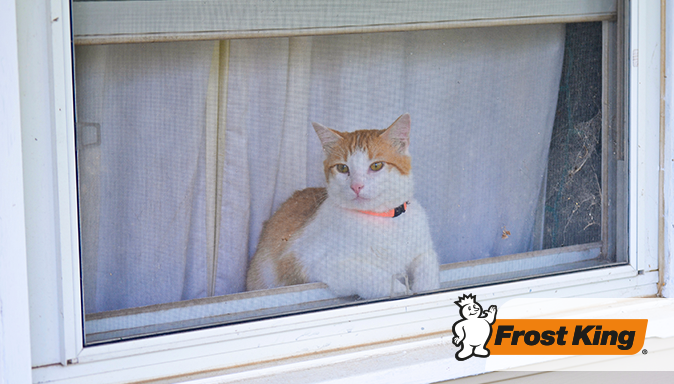Are you ready to shut the door on air leaks around your entryways? Adding weatherstripping is a simple, inexpensive DIY that pays off with big results all year long: it stops drafts in the winter and keeps cool air inside in the summer.
If your doors could use some fresh weatherseal, set aside some time to tackle this easy project. Just follow the steps below.
Know the Different Types of Weatherstripping
Start by choosing the right type of weatherstripping for your project. Frost King offers a variety of weatherstripping options for all different applications. Whether you need a cost-efficient quick fix or want a long-term solution, our all-in-one weatherseal kits can meet your needs:
• Felt Weatherseal: This is the OG of weatherstripping and is the most economical choice. To install it, you nail, tack, or staple it into place on the frame or molding.
• Poly Foam Weatherseal: This highly compressible self-stick tape squeezes down to 10% of its size to fill the narrowest gaps, and has a self-stick backing that makes it a cinch to install. While this choice is a versatile way to save energy, it is not water resistant so you should only use it for interior applications.
• Vinyl Foam Weatherseal: A step up from Poly Foam Weatherseal, this self-stick, medium compression tape is water resistant so you can use it indoors or out.
• Rubber Foam Weatherseal: While our Rubber Foam Weatherseal may be less compressible than our more inexpensive options, it’s made with memory foam so it keeps its shape and can be used indoors or out. Plus it’s water-resistant, making it an all-around option for inside and outside use.
• Premium Rubber Foam: For the greatest versatility, choose our EPDM tape that’s made to stand up to extreme weather conditions. It won’t harden, crack, or freeze and will spring back to shape even after years of exposure to sub-zero temperatures.
• Reusable Self-Adhesive Weatherseal: Our newest weatherseal innovation makes the job easier with its patented Geckskin® adhesive that allows you to get an exact fit and placement every time. Use it anywhere you have a challenging spot that needs a more flexible weatherseal—we’re talking sliding doors, double doors, narrow gaps in door jambs. Watch this video to learn how to use this innovative new weatherseal to fill gaps, even in the most hard-to-seal spaces:
Need help choosing the right weatherseal for your job? Watch this video:
How to Weatherstrip Your Door the Right Way
1. Start with a Clean Slate
Remove any existing weatherstripping, then thoroughly clean away any residue or adhesive so you’re starting with a surface that’s free clean, dry, and free of grease or grime. While you’re at it, check the door hinges and tighten any loose screws to ensure your door closes tightly.
2. Choose the Right Day
For the best, longest-lasting installation, tackle this DIY on a day when temperatures are between 40°F and 90°F.
3. Install the Weatherstripping
Now gather your tools because it’s time to add your weatherstripping. Grab a tape measure and a pair of sharp scissors. Measure the top of the door frame and both sides, then cut a piece of weatherseal to fit each side. Peel the adhesive backing from the tape and, starting at the bottom and working your way to the top of the door, carefully press it into place.
4. Install the Weatherstripping
Weatherseal can’t be installed on the bottom of the door, so check to make sure the base of your door has a functional door sweep. If you can feel a draft or see light coming through the door when it’s closed, install a door sweep, such as Frost King’s Aluminum Drip Cap and Door Sweep, which seals the threshold (where the door meets the floor) and keeps out drafts.
5. Maintain Your New Weatherstripping
If you install it properly, weatherstripping doesn’t need much maintenance. All you have to do is keep it clean and free of debris and check it periodically to make sure it’s not ripped or torn.
Before you get started, watch this video for easy, step-by-step directions to add weatherseal and a door stop to your exterior door:
